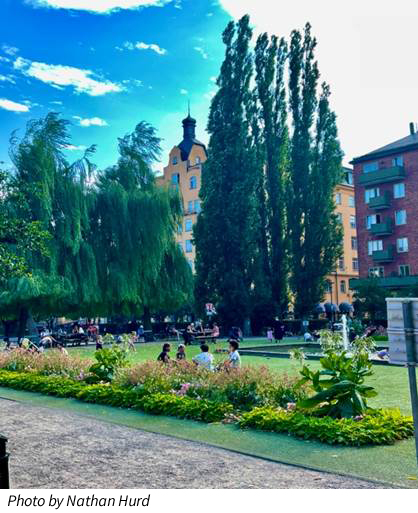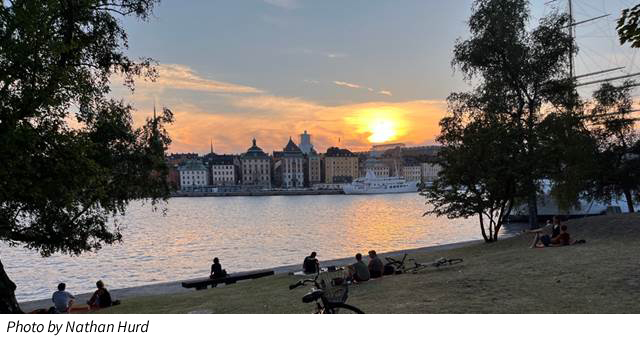Three Reasons the Baltics Are So “Rich”
Last week, I was honored to be invited to speak on a luxurious cruise through the Baltics about how to find and connect with life’s richness.
While on the cruise, there were two countries in particular that I found fascinating. They offer important lessons about living a rich and satisfying life.
Every year, the United Nation’s Sustainable Development Solutions Network produces the World Happiness Report. It rates the happiness of 155 countries based on satisfaction with things like life expectancy, GDP per capita, employment, social support, income inequality, and lack of corruption in government and business.
Both Sweden and Finland have repeatedly been listed among the 10 happiest countries in this report.
And though there are many differences between Helsinki and Stockholm – the respective capital cities of Finland and Sweden – they also have a lot in common.
Both cities are surrounded by water and are littered with parks and walkable neighborhoods. Both are clean, with beautiful marinas, bridges, restaurants and public transportation. Both have a mix of modern and historical architecture (especially Stockholm, as it was established much earlier) and a healthy dose of culture and history.
As we walked through each city and spoke with the residents, it felt so… civilized.
And I couldn’t help but wonder…
If these are some of the “happiest places on Earth”… why?
What Makes These Places So Happy?
In the West, we think of these countries as “socialist,” but that’s not my point here. In fact, they are far bigger free-market economies than many understand. Chief Investment Strategist Alexander Green has written extensively about their embrace of capitalism.
I’m not going to debate the merits and downfalls of socialism here. I’m a conscious capitalist who believes in free markets and personal freedoms. When I touch back down in the U.S. after traveling overseas, I know I’m home.
There are, however, three cultural concepts that I believe underpin these countries’ “happiness” and can help each of us experience more richness in our daily lives.
In Helsinki, our guide informed us that the entire bay is frozen from about September to May. She told us that despite the cold, which can drop as low as minus 60 degrees Fahrenheit, half the population actually prefers the winter months.
Apparently, these winter lovers embrace and enjoy the “refreshing” low temperatures, winter sports and the ability to walk across the bay – an empowering perspective on long, cold winters.
Saunas are a pastime enjoyed almost daily, and it’s not uncommon for Finns to “spank” their own backs with birch branches to release tension as they sweat it out in the sauna. Many engage in outdoor swimming during the winter months. All of this promotes health and wellness.
And this brings me to the first concept.
The Finnish have a concept called “sisu.” It has no direct translation in English, but it can be described as a unique form of Finnish fortitude that is accessed on a daily basis to help face challenges big and small, a kind of “stoic determination.”
Sisu is the part of you that pushes through and says “I got this” when you’re dreading a meeting or biking up a hill on a cold day, according to Finnish philosopher Frank Martela.
Finnish people don’t necessarily come across as joyful. In fact, according to Martela, Finland is “the land of quiet satisfaction.”
He also says the Finnish are happier because they are more accepting of negative emotions. They don’t shy away from them, and they aren’t afraid to talk about them.
Since we all face hardship and tragedy at some point of our lives, accepting unhappiness when it occurs – and being okay with it – ends up supporting greater happiness in the long run.
Not Too Much, Not Too Little
The Swedish people we encountered were kind and considerate. While walking around, we accidentally ventured into a bike lane, and the bikers we cut off simply rang their bells, slowed down, allowed us to pass and kept going. No road rage in sight.
In fact, in Stockholm, we saw more bikes than cars. And in both cities, they ride bikes year-round, despite the cold.
Tips for service workers are not expected in either culture, yet our waiters and hotel staff were charming and sincere. On our final morning in the city, we had to leave before breakfast started to get to the airport. The hotel receptionist offered to set a table 45 minutes early, just so we could eat. We were treated to a private breakfast for two by candlelight.
The night before, at dinner, I was struck when the waiter came by to clear our dishes and asked, “Do you feel satisfied?”
The phrasing of this question is indicative of an important Swedish concept called “lagom” that underpins their philosophy on life and overall contentment. Again, there is no English translation, but it roughly means “not too much, not too little,” “sufficient” or “adequate.”
This is reflected in the portions they serve, the way they balance their daily activities, the number of material goods they long for and their approach to just about everything.
Rich in Coffee and Cake?
There is one last concept worth mentioning. This one is also Swedish, but its underlying meaning reflects what I believe to be the greatest piece of the puzzle.
It’s called “fika.”
Fika is a state of mind. It’s a practice that Swedes make time for every day, sometimes translated as “coffee and cake break.”
But that’s not quite it. Eating coffee and cake alone at your desk would just be a moment of solitude. Fika involves recharging through social interaction. It’s about hitting pause on the demands of life to eat, drink and connect with family, friends and colleagues.
It’s this concept that really tipped the scales for me. It’s representative of what I believe is the key to the higher levels of contentment and happiness we see in both countries.
The Finnish, the Swedish and some of their other Nordic cousins have cultures that prioritize companionship and camaraderie.
They understand that they need one another. They value one another. And they understand that they each have a part to play in the betterment of the collective.
This is why the people seemed tolerant, patient and kind.
This is why the goal of each meal was simply to “feel satisfied.”
This is why there’s less competition for status.
This is why the parks were filled with beautiful moments of friends and couples connecting.

A park in “Old Town” Stockholm

Watching the sunset over the Baltic Sea
So it’s not surprising that both countries rank very highly when residents were asked whether they have someone they could count on completely if times got tough.
After this recent trip to the region, it’s clear to me that there are good reasons they tend to rank among the happiest countries. They have, for lack of a better phrase, cultures that prioritize human connection.
Who couldn’t benefit from that?
To have fortitude when times get tough – sisu. And to accept negative emotions and be willing to talk about them rather than bury or run from them.
To think about when enough is enough – lagom.
To prioritize companionship and camaraderie – fika. To remember that we need one another more than we think. To protect our freedoms and also one another.
It’s no surprise that the longest-running study on human happiness ever conducted came to the same solution.
Our connection with each other is the richest thing we have.
Until next time…
Be relentless,
Nathan
P.S. Have you ever been to these countries – or any others that seem to radiate contentment? I’d love to hear your thoughts on this topic. Just click here to send an email.